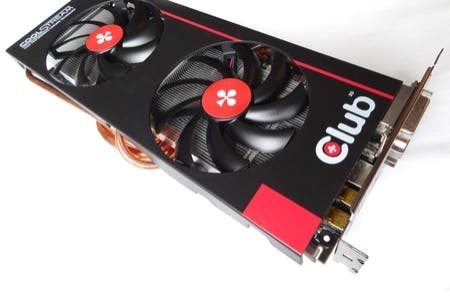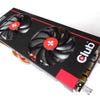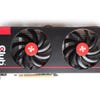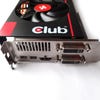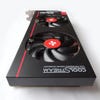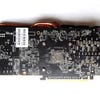Radeon HD 7870 Review
AMD is back in the game as the 7870 slips below £200 - Digital Foundry takes a look at a new overclocked version of the enthusiasts' favourite.
With each new generation of graphics cards, the tussle for market dominance between AMD and NVIDIA has made for some radical beat-downs and come-backs over the last few decades. Through it all, of course, it's the buyer that has benefited from each company's determination to design for optimal cost-efficiency in each price bracket. Runaway successes on the scale of the now-legendary 8800GT are few and far between, but there are still cards, branded in allegiance to either green or red camps, that unexpectedly surge ahead of the pack.
Though a sterling performer, we found NVIDIA's latest GTX 660 Ti only made conservative efforts to distinguish itself in terms of value. Compared to the preceding GTX 670, it continues to be welcomed as the cheaper card, but ultimately, performance scales back in a near-proportionate manner to the price. In all, we saw it as worthwhile option for those budgeting for £240-£250 - but what if you could get away with comparable performance for even less?
To find out, we grabbed an early hands-on with Club 3D's upcoming overclocked Radeon HD 7870. Set for release at around the £200 mark in the coming weeks, this so-called "royalAce" edition of the card features a proprietary PCB design and an open, twin-fan cooling system, reminiscent of the configurations we see on MSI and Asus' enthusiast ranges. As a result of these modifications, the core clock is ramped up by 10 per cent for this edition: going from the 1000MHz on the reference model to 1100MHz.
This is a smidgen higher than the GTX 660 Ti while in a boosted state, rated at 1098MHz, involving no major tweak to the reference model's 12.25v power rating. This is a testament to the heat and energy efficiency of its underlying Pitcairn architecture, where the extra headroom grants third party vendors some flexibility to experiment. Much like the other entries in the 7xxx series, the 7870 is also based around AMD's Graphics Core Next design profile, being produced via a 28nm manufacturing process, offering first-time support for PCIe 3.0, and greatly improving tessellation tasks and power-saving features across the board.
"The new Club 3D Radeon HD 7870 royalAce edition features a core clock boost up to 1100MHz, along with a custom cooling solution compared to the standard reference model."
When it comes to the divide between red and green, there are a few points of interest. As well as the 7870's marginal core clock lead, the card utilises 32 Render Output Units (ROPs) and a 256-bit memory bus, as opposed to the 24 ROPs and cut-down 192-bit bus seen on the GTX 660 Ti. Conversely, NVIDIA's card takes charge with 1344 stream processors and its whopping 6008MHz memory clock. In theory, this allows for superior multi-tasking with shader effects, and a higher fill-rate than is possible with the 7870's offering of 1280 stream processors and 4800MHz memory. It's a mixed bag, but they do each find a common ground in their use of 2GB of GDDR5 RAM.
Next, we look at the physical aspects of the card . This edition of the 7870 counts in at 268mm in length - just one millimetre longer than MSI's 660 Ti Power Edition. On top, we see three intertwined copper pipes bending out from different sections of its aluminum fin array. A lion's share of the ventilation to this heatsink is handled by the twin CoolStream fans at the front, though the open-shell design also permits air to circulate from around the PC to the top and bottom of the card. In practice, this doesn't amount to any more noise than the HD 7850, and avoids the rising sound signature of the previous generation's 6870.
We see plenty of connectivity options when we turn it to the end, starting with two Mini DisplayPorts, a HDMI v1.4a port, and two dual-link DVI-I connections. To bolster this, we're surprised to also find a generous a range of converter cables bundled in too,which would otherwise cost us a pretty penny. With these we can convert either of these smaller DisplayPort connections to more popular standards like DVI or HDMI, plus there's one to bridge the gap between DVI and HDMI.
Talking power, the card requires two 6-pin PCIe connectors to run. The 7870's reference model is rated at 175W TDP (thermal design power), but rival cards with an equivalent overclock tend to lurk at the 190W end, putting this version on par with the GTX 660 Ti's rated throughput. Nevertheless, due to the ZeroCore technology leveraged into the architecture of 7xxx series, idling on the desktop automatically scales this figure down to just 15W when possible, achieved by reducing the clock speed to 275MHz, and changing the state of its DRAM chips.
Despite the card's augmentations, heat remains at a cordial 29 degrees Celsius while idle on desktop. Meanwhile, keeping tabs on the GPUs thermal sensors while running the 3DMark shows us a maximum temperature of 74 degrees. Sadly, this isn't a staggering overhead to work with when it comes to overclocking compared to other cards, but light tweaks are easily feasible.
Radeon HD 7870: Performance Analysis
To get an idea of what these numbers actually amount to, we run the card through two strenuous 3DMark 11 benchmark tests. The first is at 1280x720 for the Performance grade, and the second at 1920x1080 for the Extreme grade, where both tests guide us through a series of complex oceanic and jungle-based environments.
As a synthetic DirectX 11 assessment, these show us how the 7870 copes with tessellated geometry in particular, and to what degree it improves on the previous generation's HD 6870. We also get an idea of how the card compare with its cut-down Pitcairn-based sibling, the HD 7850, and of course, the rivaling GTX 660 Ti.
The testing methodology is straight-forward; we install each of these cards into our high-end rig to eliminate bottlenecks as best we can. Our setup features the popular Intel i5-2500k processor overclocked to 4.2GHz, working in conjunction with 8GB of 1600MHz RAM, and with all mentioned applications running straight from a 90GB Kingston HyperX SSD. This also includes the Batman Arkham City and Metro 2033 benchmarks, featured below.
"There's a curious disparity between 3DMark and gaming benchmarks, with the 7870 moving ahead of the 660 Ti on the latter despite being comprehensively outgunned on the former."
| HD 6870 | HD 7850 | HD 7870 | GTX 660 Ti | |
|---|---|---|---|---|
| Metro 2033 Average FPS | 18.67 | 23.33 | 27.38 | 25.08 |
| Batman AC Average FPS | 48.00 | 51.00 | 67.00 | 60.00 |
| 3DMark 11 Score | X1393/P4441 | X1647/P5492 | X2180/P6907 | X2854/P8500 |
| 3D Mark 11 Graphics | 1244/4133 | 1473/5534 | 1983/6798 | 2631/8937 |
As far as the 3DMark results are concerned, it's a wash. The 660 Ti blitzes the 7870 on both counts, with the Extreme pass raking in an additional 32 per cent in graphics score, and almost as much with the total score. Performance tests are closer still, but the handling of each suggests that NVIDIA have cut-down this Kepler card in all the appropriate areas, with the lesser memory bandwidth and ROPs count having a minimal impact. However, compared to the 7850, we see Club 3D's overclocked 7870 delivering an equivalent leap in performance.
With this in mind, our expectations are defied when we find benchmarks for both Batman: Arkham City and Metro 2033 favouring the AMD card by a clear margin. We run each test at 1920x1080, at very high quality settings, with DirectX 11 features such as tessellation and depth of field enabled in each case. For Arkham City, we even have MSAA ramped up to 8x to truly get the memory buses sweating with Unreal Engine 3 - likely the one area where the 660 Ti is falling short. The Metro 2033 lead is less drastic overall at just 2FPS north, but it still gives us a clear sign that the 7870 deserves to be in contention with a much more expensive card.
Gameplay Analysis: Video Benchmarking
Even by today's standards, playing games like Crysis 2 and Battlefield 3 at 1080p with maxed-out settings is akin to taking your graphics card through a virtual military obstacle course. Both of these DirectX 11 titles remain nefariously difficult to keep ticking at a locked 60FPS once the action starts proper, but represent a glimpse of features that future games may hold. For the next round of tests, we take to comparing matching gameplay scenarios in the above two first-person shooters, and also The Elder Scrolls V: Skyrim. To kick off, we take look at Crytek's latest.
"The Radeon HD 7870 remains close to the 660 Ti during scripted cut-scenes, but intense gameplay does see the NVIDIA card pull away from its rival."
- Alternative Analysis: Crysis 2 1080p max settings, Radeon HD 7870 vs. 7850
- Alternative Analysis: Crysis 2 1080p max settings, Radeon HD 7870 vs. 6870
Even running on the Kepler kingpin, the GTX 680, we found Crysis 2's frame-rate dipping at points. So in the case of the 7870, we're given a very clear ultimatum regarding performance. Having the optional DX11 and high resolution texture packs installed is an absolute must to get the authentic CryEngine 3 experience, adding major visual features such as particle shadowing, displacement mapping and tessellation into the mix. However, it's clear the card can't live up to the 1080p60 dream with all of these extra effects cranked up to ultra quality. The high standard of post processing is a major culprit for drops to 35FPS we see here, along with the advanced shader settings, meaning it's necessary to drop down to the Extreme setting to make this play smoothly.
Compared to the 660 Ti, this is respectable. In fact, for much of the initial scene involving a capsizing submarine, we see the readings of each card sticking together closely. The scene is explosive in nature, with fire effects, smoke, and water shaders all running in tandem; a true set-piece. The situation changes during shoot-outs during the later levels, where the chasm in performance is widened noticeably. The 7870 remains up to 10FPS short of the rival card's value, and rarely gets a touch of the FPS ceiling. For those willing to cap at 30FPS this is certainly playable, but otherwise graphical compromises have to be made.
The same argument can be voiced for the budget-focused 7850. If 1080p30 with maximum settings is the ideal, then paying out £130 for this card seems like an even more economical approach. Throughout our tests, we experience nary a drop below that value on either 7xxx series cards, though the same can't be said of the Barts-based war horse that is the 6870, where our demand for v-sync sees some consistent drops to just 1080p20.
"No real surprises with Skyrim: we see a very similar level of performance between the 7850, the 7870 and the 660 Ti - essentially we have a surfeit of power on all three cards."
- Alternative Analysis: Skyrim 1080p max settings, Radeon HD 7870 vs. 7850
- Alternative Analysis: Skyrim 1080p max settings, Radeon HD 7870 vs. 6870
As far as performance in Bethesda's Skyrim is concerned, there's little to distinguish the 7870 from the GTX 660 Ti. We see the odd lost frame when halfway through Helgen village, occurring at matching points for both cards - suggesting this is a streaming issue for our SSD more than anything else. But that's it. Even at this high level of demand on the 7870 we see no cause for complaint. Texture and shadow quality settings happily sit at ultra, while the fade-in for distant geometry and characters run smoothly at 15.
In terms of getting 1080p60 from Skyrim at these settings with the cheapest card possible, the cheaper 7850 is a very viable candidate. The downhill descent, as always, is the most treacherous part, and yet the card holds its head high for 90 per cent of the scripted journey. The dips it does make down to 50FPS don't detract from the illusion of fluid feedback, though these aren't regular fixtures during the general run of play. To smooth these rough edges, dropping the high levels of MSAA down to 2x gives a sufficient amount of head-room.
To round out our video tests, we have DICE's flagship modern shooter, Battlefield 3, to show us how a game built specifically around the DirectX 11 API runs on mid-range graphics cards. Opting for this preset is really jumping in at the deep end. It forces 4x MSAA in support of the already active high quality FXAA, pushing the 7870's memory bandwidth - rated at 153.6GBps - beyond its limits. By contrast, the GTX 660 Ti has equivalent struggles during both outdoor battles, but holds the higher ground by 5-10FPS in matching situations.
In all, we find our enjoyment is impacted by the wild frame-rate fluctuations. The console versions each run at a locked 30FPS that feel all the smoother for sticking to a factor of the commonplace 60Hz refresh rate, and a similar cap would definitely benefit play here. This is eminently possible by entering "GameTime.MaxVariableFPS 30" into the command line. However, an easier alternative would simply be to drop the quality preset to high, where 60FPS is attainable on both the 7870 and 660 Ti.
"1080p60 at ultra settings proves to be too much for all the GPUs we tested, but performance is much the same between the Radeon HD 7870 and the GTX 660 Ti on Battlefield 3's high settings preset."
- Alternative Analysis: Battlefield 3 1080p max settings, Radeon HD 7870 vs. 7850
- Alternative Analysis: Battlefield 3 1080p max settings, Radeon HD 7870 vs. 6870
It does bear mention that a blue hue is apparent on shaded areas during the latter half of the Operation Swordbreaker stage, as captured in action here while using our 7870. This is a glitch resulting from deferred AA being engaged in the menus, and is mainly viewable in areas with that utilise global illumination. The Catalyst Control panel is fully updated to version 12.8 in our case, with all graphical settings set to default, leading us to believe this is a minor incompatibility with the game itself. Fortunately, we only notice the glitch occurring during this one level of Battlefield 3, and no other titles appear affected.
As far as performance on the cheaper 7850 is concerned, Battlefield 3 plays comfortably at 1080p60 using medium settings, though any higher and the frame-rate is liable to shake at moments when those frames are most needed. If 60FPS consistency at the high preset is the target, then the 7870 strikes a healthy balance in offering all the specs necessary to achieve it, and for a cheaper price than the GTX 660 Ti. Ultimately, competitive players will find ultra to be a write-off in either of these cases, making this the next best option.
Gameplay Analysis: The Best of the Rest
To cover performance in some less strenuous titles, we test the 7870's mettle when confronted with the likes of Portal 2, Modern Warfare 3 and Diablo 3. These are each designed to work on as many PC configurations as possible to expand their potential following, making maxing these three out at 1080p a doddle. To show the extent of the over-delivery, where each of these are capable of some absurdly high frame-rates, we drop the v-sync entirely.
The opening New York stage of Modern Warfare 3 runs at near-identical speeds on both the 7870 and 660 Ti, though slumps by 30FPS when being tackled on an overclocked 7850. Even on the two-year old 6870, movement feels appropriately snappy for a series predicated on twitch motions, and owners of 120Hz monitors can take full advantage of this rapid level of feedback, regardless of which card is being used here. This level of optimisation also extends to Valve's Portal 2, which builds its experience around relatively simple, clinical building blocks in order to service the intuitiveness of each puzzle. In performance terms, this qualifies both the 7870 and GTX 660 Ti for sky-high values, where the additional frames would no doubt be better spent on other processes, such as stereoscopic 3D rendering.
"Diablo 3 and Saints Row: The Third apart, the Radeon HD 7870 proves to be highly competitive against the more expensive NVIDIA GeForce GTX 660 Ti."
| HD 6870 | HD 7850 | HD 7870 | GTX 660 Ti | |
|---|---|---|---|---|
| Call of Duty: Modern Warfare 3 | 117.5 | 127.9 | 157.6 | 158.3 |
| Diablo 3 | 90.4 | 99.7 | 105.7 | 163.9 |
| DiRT 3 | 74.4 | 90.5 | 109.7 | 122.1 |
| Portal 2 | 167.6 | 188.5 | 247.6 | 259.0 |
| Saints Row: The Third | 34.8 | 40.6 | 41.8 | 54.0 |
| StarCraft 2 | 69.2 | 74.5 | 82.9 | 89.6 |
Diablo 3 shows us the first major gulf in performance with these tests, where the 660 Ti offers in excess of a 50 per cent lead over the 7870's frame-rate. This involves a hacking and slashing our way from the centre of New Tristram town to the first waypoint in the Old Ruins. The settings are entirely at full capacity, with shadows receiving additional smoothing and AA engaged.
Ultimately, the game thrives on every GPUs we've tested, though the same can't be said for StarCraft 2 at peak settings. The FRAPS averages can be deceptive in this case, as much of our 4v4 replay on Kula's Ravine involves piddling macro play with only occasional flashes of confrontation. Having two armies face off at the 15 minute mark reduces the 75FPS standard to around 50FPS on our 7870. This is troublesome for most experienced players, as such a level of inconsistency in feedback can cause a game-ending mis-clicks. In this case, it's best stick to high settings to err on the safe side.
The most demanding game in this list would undoubtedly be Saints Row The Third, a brilliantly daft sandbox title - the opening gambit of which involves taking down legions of re-spawning henchmen while being hoisted by a crane between skyscrapers. We run it in DX11 mode and find that only the GTX 660 Ti is capable of delivering this set-piece at something remotely close to 60FPS. The 7870 is just a frame on average ahead of the 7850, meanwhile, which forces us to lower the settings to keep performance on an even keel. Given the promised advances in handling tessellated geometry, we had hoped to see a wider margin of improvement over the 6870 with this game overall.
Radeon HD 7870: The Digital Foundry Verdict
In review, Club 3D's overclocked edition of the HD 7870 is amply configured to play many of the grander titles of the moment, and at £200, should strike a chord for those whose budgets can't quite stretch to NVIDIA's GTX 660 Ti. Comparing the two, the AMD card's higher core clock speeds and wider memory bus are definite pluses, but on paper the other specs do inevitably tend to favour the latter, pricier card. The net result is that performance in Skyrim peaks on both at 60FPS while at maximum settings, whereas Crysis 2 and Battlefield 3 struggle to hit that same level, with NVIDIA's card typically ahead.
"Offering excellent value at £200, the Radeon HD 7870 is a worthy contender for your next PC upgrade, but paying an additional £30 for the 660 Ti may pay off in the longer term."
At a current difference of £30-£40 there isn't much in it in practise though. Getting demanding DirectX 11 games to run optimally takes similar degrees of sacrifice to image quality on both cards, and in the case of Battlefield 3, involves dropping down a preset with each to achieve the smoothest performance. In this sense, the saving is worth making here if you only intend to dig your feet in with the current generation of PC games. The only concern with this approach is the principle of future-proofing your purchase for next generation titles like Watch Dogs and Star Wars 1313. Pushing the boat out further could pay dividends in these cases.
As far as the card's design goes, Club 3D have pieced together a version of the card that cranks out 10 per cent extra core clock performance at little-to-no extra cost over AMD's reference model. The open, twin-fan cooling system effectively supports the augmentation, and build quality is comparable to other third party iterations out with the similar aims. Compared to the previous generation's 6870, which we bought at precisely the same price two years ago, it's a much quieter card too. The only fault we can pick out is that its overclocking potential may be stifled a little, due to the already high maximum temperatures we record under extreme load.
Overall, while the 7870 averages out with a lower price-tag than GTX 660 Ti, the comparison still isn't a clear one. This is simply because NVIDIA have continued their tradition of focusing on the GPU market's top-end with its Kepler architecture, and slowly scaling down with each subsequent redesign, from the 680 to the 660 Ti. As such, it doesn't don't yet offer up a true rival in the same price bracket, with their latest model being sandwiched between several AMD cards in the mid-range. If the pattern is set to continue, we hope that it has another budget-orientated card on the PCB drawing board, ready to make that confrontation...
